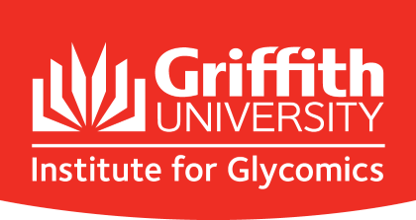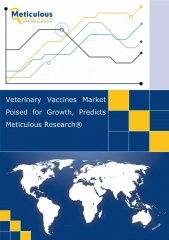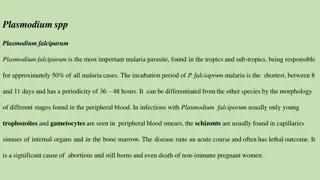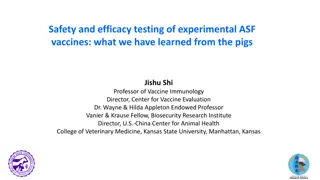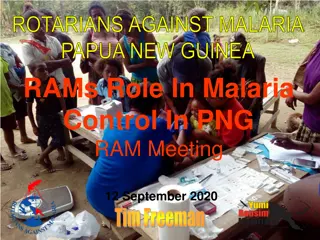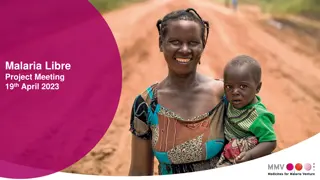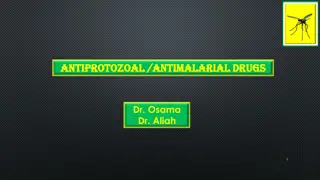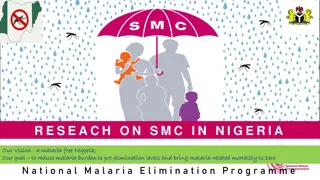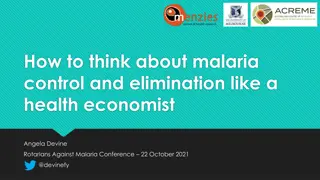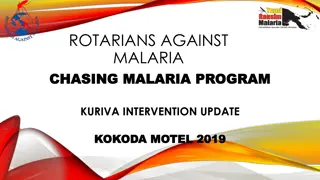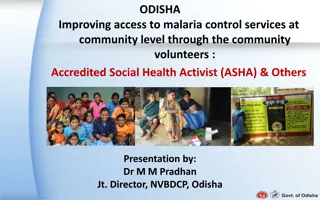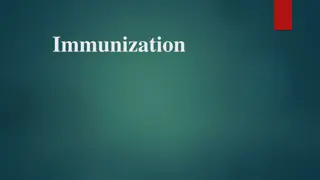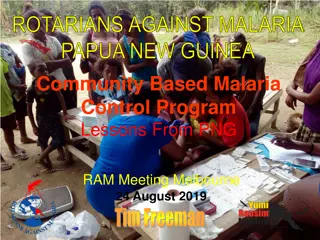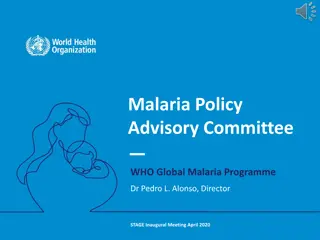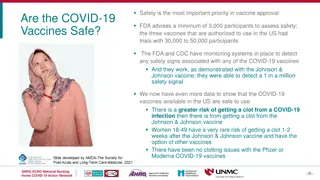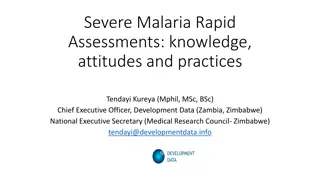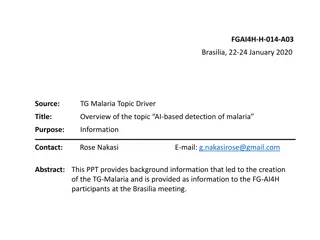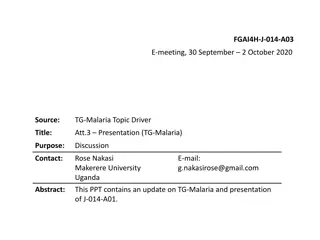Malaria Vaccines 101
Explore the complexities of malaria vaccine development, targeting Plasmodium species/stages, immunity evidence, and broad vaccine approaches focusing on sub-unit vaccines. Discover the quest for an effective and accessible malaria vaccine.
Download Presentation

Please find below an Image/Link to download the presentation.
The content on the website is provided AS IS for your information and personal use only. It may not be sold, licensed, or shared on other websites without obtaining consent from the author.If you encounter any issues during the download, it is possible that the publisher has removed the file from their server.
You are allowed to download the files provided on this website for personal or commercial use, subject to the condition that they are used lawfully. All files are the property of their respective owners.
The content on the website is provided AS IS for your information and personal use only. It may not be sold, licensed, or shared on other websites without obtaining consent from the author.
E N D
Presentation Transcript
Malaria Vaccines 101 Dr Danielle Stanisic Laboratory of Vaccines for the Developing World Institute for Glycomics, Griffith University
Why dont we have a malaria vaccine? -Complexity of the parasite Which Plasmodium species should a vaccine target? -There are 6 main species of malaria parasite that infect humans: Plasmodium falciparum and Plasmodium vivax are dominant. What Plasmodium stage should be targeted? (multi-stage?) -eliminate infection? -reduce disease? -prevent transmission? What do we want a malaria vaccine to do? Affordable, capable of inducing long-term immunity, well tolerated and non-toxic
Evidence for Anti-malarial Immunity: Experimental Malaria Infection Studies Julius Wagner-Jauregg, Austrian physician Nobel Prize in 1927 was "for his discovery of the therapeutic value of malaria inoculation in the treatment of dementia paralytica. From 1917-1940 s clinical malaria was used to treat tertiary syphilis. -Reductions in the number of episodes of fever and parasitemias over time. -Infection resolved in some individuals without drug treatment.
Experimental Malaria Infection Studies -Immunity to re-infection with P. falciparum _____ Sporozoite-induced primary infection ---------- Blood-induced primary infection . Blood-induced secondary infection Collins & Jeffery, AJTMH 1999
Evidence for Anti-malarial Immunity: Studies in Malaria Endemic Areas Is acquired gradually and is age/exposure related. In areas of high endemicity, most of the clinical disease is in young children. Asymptomatic adults may have low levels of parasites in their blood. Immunity is not sterilising and individuals living in endemic areas are continually re-infected. Immunity manifests as a reduction in clinical symptoms and parasite levels.
2 Broad Malaria Vaccine Approaches Sub-unit vaccines Contain a small part of the parasite eg a single protein Require adjuvants Proteins diversity: greatest challenge for sub-unit vaccines. -Proteins are often variable between different parasite strains -Can impact on maintenance of the immune response -Has been shown to impact on vaccine efficacy Strategies -Multi-allelic vaccine (different types of the same antigen) -Multi-protein vaccine (different protein) -Focus on conserved proteins (the same between different strains)
Whole Parasite vaccines Many different protein targets including proteins that are the same (conserved) between parasite strains. May overcome issues associated with protein variation. Must induce a different type/magnitude of immune response than during natural infection. Must be able to accelerate acquisition of immunity (can t take years). Different approaches: chemically attenuated, genetically attenuated, radiation attenuated of killed parasite.
Malaria Vaccine Technology Roadmap -The Malaria Vaccine Technology Roadmap, facilitated by WHO, outlines the global strategy to accelerate research and development (R&D) for malaria vaccines. -Last updated in 2013, the Roadmap forms a strategic framework that underpins the activities of the global malaria vaccine R&D community. GOALS (P. falciparum and P. vivax) -Develop malaria vaccines with protective efficacy of at least 75 percent against clinical malaria by 2030. -Develop malaria vaccines that reduce transmission of the parasite in order to substantially reduce the incidence of human malaria infection by 2030. https://www.who.int/publications/m/item/malaria-vaccine-technology-roadmap
Leading malaria vaccine candidates Duffy et al, npj Vaccines, 2020, 5:48.
The process for developing malaria vaccines Vaccine efficacy: How many people who got vaccinated developed the outcome of interest (usually disease) compared with how many people who got the placebo (dummy vaccine) developed the same outcome.
Phases of clinical trials Controlled human infection study to measure efficacy before expensive field trials
RTS,S/AS01 (Mosquirix): sub-unit vaccine AS01 (Adjuvant): Oil in water + MPLA + QS21 -produced by GSK
RTS,S (Mosquirix)- Development timeline Total development cost estimated at $US605 million
RTS,S/AS01 (Mosquirix) -Is the only malaria vaccine to successfully complete Phase III testing in >15,000 infants and young children in 7 countries in Sub-Saharan Africa (2009-2014). -In children with 3 vaccinations, efficacy was 45% at 20mths, falling to 28% at 48 mths. -A fourth dose administered 18mths after primary series improved efficacy (36% at 48mths). -Over a period of 7 years, vaccine efficacy was estimated at 4-7%. There was some rebound. Strain specificity of the immune response: Vaccine efficacy against matched strains (10% of all strains) was 50.3% and 33.4% against non-matched strains over 48mths.
R21: next generation RTS,S vaccine R21 contains the circumsporozoite protein and the fused hepatitis B virus surface protein. (No free HBsAg like in Mosquirix). Formulated with the adjuvant, Matrix M. In infants, 3 doses gave 77% efficacy against clinical malaria over a one-year follow-up period Matrix M adjuvant + antigen (Saponin-based adjuvant) First malaria vaccine to meet WHO s goal of 75% efficacy. Further studies needed in more people, at multiple sites with longer follow-up. Developed by University of Oxford. Will be manufactured by Serum Institute of India
PfSpz: purified radiation attenuated sporozoite vaccine Developed by Sanaria. Infected mosquitoes are treated with optimal dose of radiation. Sporozoites are purified from mosquito salivary glands and injected intravenously. Their development arrests in the liver. Complete protection in malaria-na ve humans with 5 doses of vaccine. Initial studies in malaria endemic areas, 51% vaccine efficacy in adults with 3 doses (against infection). No significant efficacy in infants. Further optimisation with dosing regimens etc being undertaken.
Numerous sub-unit vaccine candidates that target the blood-stage of the parasite have been examined in field trials. -Merozoite protein 3 -Apical membrane antigen 1 -Serine repeat antigen 5* -Merozoite protein 2 -Merozoite protein 1 (42 kDa region) -GMZ2 (MSP3 and GLURP fusion protein)* Most have demonstrated limited or no efficacy -variation in proteins between different parasite strains. -high levels of antibodies required. -multiple pathways for parasite to invade red blood cell.
PfRh5 (P. falciparum Reticulocyte Binding Protein Homologue 5) The interaction between PfRh5 and its receptor is essential for merozoite invasion of the red blood cells. Is a highly conserved protein-good vaccine candidate. Vaccine needs to induce high levels of antibodies to block PfRh5 from binding to its receptor. This will prevent parasite invasion. Vaccination of malaria-na ve humans with PfRh5.1/AS01 resulted in a significant reduction in parasite growth rates in vaccinees following challenge with controlled human malaria infection. Developed by University of Oxford
AMA1-RON2 (Apical membrane antigen 1-RON2 The interaction between AMA1-RON2 is essential for invasion of the parasite. Need high levels of antibodies to disrupt this. When tested in the field, AMA1-based vaccines were not protective. AMA1 is highly polymorphic (ie different parasite strains contain different types of the antigen). Has been proposed that a vaccine containing up to 9 different AMA1 types could induce a broad protective immunity against all strains. (Multi-allelic vaccine approach)
Vaccines targeting the parasite in the mosquito Parasite proteins expressed on the sexual gametocyte stage in the human host and the mosquito stages are being developed as vaccines. Vaccines aim to stimulate antibodies that block parasite development in mosquito. Leading vaccine candidates: Pfs230 and Pfs25. These proteins are attached to a carrier protein- EPA which improves the immune response. In Phase I trials, the vaccines stimulate antibodies that block parasite transmission in laboratory tests. Antibodies don t last long after final boost.
P. vivax vaccines 80% of global P. vivax burden is in Asia and Asia-Pacific region. Leading vaccine candidate: Duffy Binding Protein (DBP). Only one so far to reach Phase Ib trial. PvDBP binds to the Duffy antigen on red blood cells. Polymorphisms in Region II of the protein (important for binding) - challenge for vaccine development. In human studies, DBPII vaccine- stimulated antibodies could stop parasite growth in laboratory tests.
Pregnancy-associated malaria (PAM) vaccine Pregnant women are more susceptible to malaria than non-pregnant women. This increased susceptibility is seen most commonly in the first pregnancy. Can result in maternal death, pre-term delivery, miscarriage, and stillbirth. The placental infection can also result in foetal growth restriction leading to low birthweight (LBW) of the infant. In 2019, approximately 12 million pregnancies were exposed to malaria infection, mainly in Africa. Annually, malaria during pregnancy results in approx 900,000 children with LBW and up to 10,000 maternal and 200,000 infant deaths.
Pregnancy-associated malaria (PAM) vaccine Sub-set of malaria parasites that bind to a receptor in the placenta (CSA). Develop vaccines that will block placental- binding malaria parasites. Two malaria in pregnancy vaccine candidates, PAMVAC and PRIMVAC, have been tested in Phase I trials in non- pregnant women. These vaccines contain parts of the parasite protein (Var2CSA) that binds to the CSA receptor on the placenta. These vaccine candidates were shown to be safe and induce an immune response.
What about mRNA vaccines for malaria? Parasite Parasite antigen The genetic sequence of the parasite antigen is used to make a synthetic mRNA sequence The mRNA is packaged into a nanoparticle the vaccine which can deliver the mRNA to immune cells The immune cells follow the mRNA to produce the parasite antigen which is displayed in the cell surface. This stimulates an immune response. Pfizer have announced they will be using their mRNA technology to develop a malaria vaccine Selection of antigen??
Thoughts Who should be immunized? Vaccine efficacy (controlled trials) vs vaccine effectiveness (real world) How long should protection last? Minimal required efficacy? Cost of vaccination Protection against different strains and species? How to develop new vaccines after licensure of RTS,S? Vaccine fatigue in malaria endemic areas


